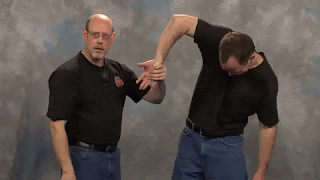Juche is a controversial pattern. It is often cited as being too "flashy", full of challenging kicks rather than practical fighting techniques. Juche is the last of the five "new" patterns; the others being Eui-Am, Yong-Gae, So-San, and Moon-Moo. These patterns were added to the original 20 in order to incorporate more physically challenging techniques. Juche shares similarities to these four previous patterns, such as the slow motion turning hook kick from Moon-Moo.
But Juche's challenging design doesn't exclude self-defense applications. Take steps 37-39:
- 37: Flying two-direction kick (twisting kick with left leg, side kick with right leg), also called a "split kick"
- 38: Land in left diagonal stance twin palm rising block
- 39: Step left leg forward and turn clockwise into right cat stance side elbow thrust
From a standing position, it would appear we are kicking two separate opponents at once while defending a downward strike from a third opponent. But remember that in patterns we actually face
a single opponent, not multiple opponents from different directions. While the two-direction kick doesn't make much sense from the air, it does make sense
from the ground as a knee bar. This technique appears in at least two old karate manuals:
The Bubishi and in Kenwa Mabuni's 1938 book
Karatedo Nyumon.
 |
| Two-direction kick application from The Bubishi (left) and Kenwa Mabuni (right) |
Here the top of the foot for the twisting kick is used to hook the opponent's heel, while the side kick pushes the opponent's knee. This straightens their leg and forces them to fall over. You can watch a video of
the technique here. Given that Gen. Choi and his commanders read various karate manuals, and that Juche was the last pattern created, I believe there's a good chance they came across this technique and that it is the inspiration for the two-direction kick.
A variation is to switch the feet: use the side kick to hook the angle (pulling with the back of your foot) while you use the twisting kick to push into the opponent's knee. This is shown in the gif below.
The Rising Block
The takedown leaves both you and your opponent on the ground. We want to end up in a more advantageous position, so rather than simply standing up, the form instructs you to lift the opponent's leg as you stand up so that you may pin them. The leg lift interpretation explains the use of the
twin palm for the rising block, a detail that to my knowledge is unique to Juche.
Ironically, the application from the
Encyclopedia of Taekwon-Do (right) is close to what I envision for the set. But rather than defensively blocking an axe kick, you are actively lifting the opponent's leg as you get up from the ground, and they are ideally still on the ground. Also, the fact that we are in a left diagonal stance suggests to me that we lift the opponent's right leg, rather than their left leg as is shown in the right image.
Finally we use step 39, the clockwise turn into the side elbow thrust, to twist the opponent's ankle, forcing them (if they are on the ground) to spin onto their belly.
 |
| Turning 180-degrees while twisting the leg or foot can force the opponent onto their stomach. Image source: Judoinfo.com/leglocks |
After we flip the opponent onto their stomach we can disengage. To reiterate: we lift the opponent's
right leg and turn
clockwise to flip them. One way you might do this is to grip the opponent's toes with your right hand and their heel with your left hand as you twist their foot with the turn into the side elbow thrust.










